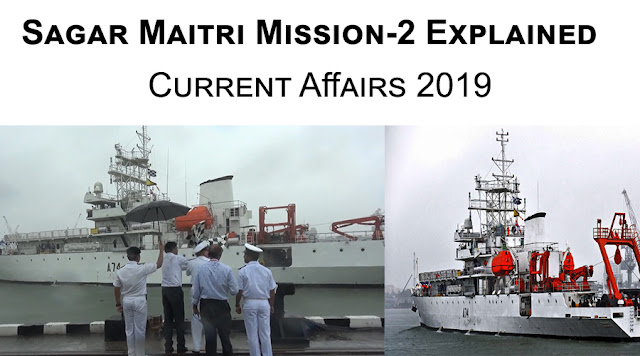What is SAGAR MAITRI (SM) Mission-2?
About the Mission
Oceanographic research vessel (A research vessel (RV or R/V) is a ship or boat designed, modified, or equipped to carry out research at sea. Research vessels carry out several roles. Some of these roles can be combined into a single vessel but others require a dedicated vessel. Due to the demanding nature of the work, research vessels are often constructed around an icebreaker hull, allowing them to operate in polar waters.) of Defence Research and Development Organisation (DRDO), INS Sagardhwani, embarked on a two-month-long SAGAR MAITRI (SM) Mission-2 from South Jetty, Southern Naval Command (SNC) in Kochi today. Secretary, Department of Defence R&D &Chairman DRDO Dr. G Satheesh Reddyflagged-off the ship in the presence of Vice-Admiral Anil K Chawla, FOC-in-C (South). Raksha Mantri Shri Rajnath Singh has extended his warm wishes for the success of the Mission.Aim of the Mission
SAGAR MAITRI is a unique initiative of DRDO which aligns with the broad objective of Prime Minister Shri Narendra Modi’s policy declaration “Safety And Growth for All in the Region (SAGAR)” to promote closer co-operation in socio-economic aspects as well as greater scientific interaction especially in ocean research among Indian Ocean Rim (IOR) countries. Under the aegis of PM’s policy, specific scientific components of DRDOis “MAITRI (Marine & Allied Interdisciplinary Training and Research Initiative)”.What is the Indian Ocean Rim?
The Indian Ocean Rim Association (IORA), formerly known as the Indian Ocean Rim Initiative and Indian Ocean Rim Association for Regional Cooperation (IOR-ARC), is an international organization consisting of coastal states bordering the Indian Ocean. The IORA is a regional forum, tripartite in nature, bringing together representatives of Government, Business, and Academia, for promoting co-operation and closer interaction among them. It is based on the principles of Open Regionalism for strengthening Economic Cooperation particularly on Trade Facilitation and Investment, Promotion as well as Social Development of the region. The Coordinating Secretariat of IORA is located at Ebene, Mauritius.
The Association comprises 22 member states and 9 dialogue partners, the Indian Ocean Tourism Organisation and the Indian Ocean Research Group have observer status.
Member States
- Australia
- Bangladesh
- Comoros
- India
- Indonesia
- Iran
- Kenya
- Madagascar
- Malaysia
- Mauritius
- Somalia
- Mozambique
- Oman
- Seychelles
- Singapore
- South Africa
- Sri Lanka
- Tanzania
- Thailand
- United Arab Emirates
- Maldives
- Yemen
Dialogue Partners
Countries with the status of dialogue partners are:
- China
- Egypt
- France
- Germany
- Japan
- United Kingdom
- United States
- Turkey
- South Korea
Development of INS Sagardhwani
INS Sagardhwani has been designed and developed by Naval Physical and Oceanographic Laboratory (NPOL), Kochi, a premier systems laboratory of DRDO. It conducts ocean research experiments in the Indian waters and spearheads NPOL’s at-sea data collection activitiesAbout INS Sagardhwani
INS Sagardhwani (A74) is a marine acoustic research ship (MARS) owned by the Naval Physical and Oceanographic Laboratory (NPOL), a DRDO laboratory and is maintained and operated by the Indian Navy, and based at Southern Naval Command, Kochi.
The ship was built by Garden Reach Shipbuilders & Engineers, Kolkata, launched in May 1991,[1] and commissioned in 1994.[4] It is similar in design to the Sandhayak-class survey ships, but with the superstructure positioned amidships and a helipad forward. The vessel is designed to facilitate low noise and low vibration while carrying out acoustic programs. It has floating floors for scientific laboratories, anti-vibration mountings for machinery and equipment, balloon launching container and wind weather radar to carry out those experiments. It is also equipped with VHF sets, marine radio, and auto telephone exchange.
Internally, the ship has eight laboratories for various scientific disciplines and a mini-operating theatre with medical staff. At the stern is handling equipment for mooring and retrieving oceanographic and acoustic buoys. It can accommodate up to 82 persons, including 16 scientists, and a crew of 8 officers and 58 sailors.
Preceding Mission of SAGAR MAITRI Mission-2
SAGAR MAITRI Mission-2 commemorates the Golden Jubilee Celebrations of India’s lone research ship INS Kistna’s missions as part of the historic International Indian Ocean Expeditions(IIOE), which took place during 1962-65. As part of the mission, INS Sagardhwani will revisit the selected tracks of INS Kistna and provide NPOL scientists ample opportunities to collaborate and garner a close working relationship with the oceanographic counterparts of the IOR countries.Objectives of the SAGAR MAITRI Mission
The prime objectives of the SAGAR MAITRI Mission are data collection from the entire North Indian Ocean, focussing on the Andaman Sea and adjoining seas and establishing a long-term collaboration with eight IOR countries in the field of ocean research and development. The other IOR countries, include Oman, Maldives, Sri Lanka, Thailand, Malaysia, Singapore, Indonesia, and Myanmar. The program also aims at establishing long term scientific collaboration with these countries in the field of ‘Ocean Research & Development’ and data collection with a focus on the Andaman Sea.Director General (Naval Systems and Materials) Dr. Samir V Kamath, Director NPOL Shri S Vijayan Pillai and other senior officials also witnessed the event.
For video explanation in Hindi

Comments
Post a Comment